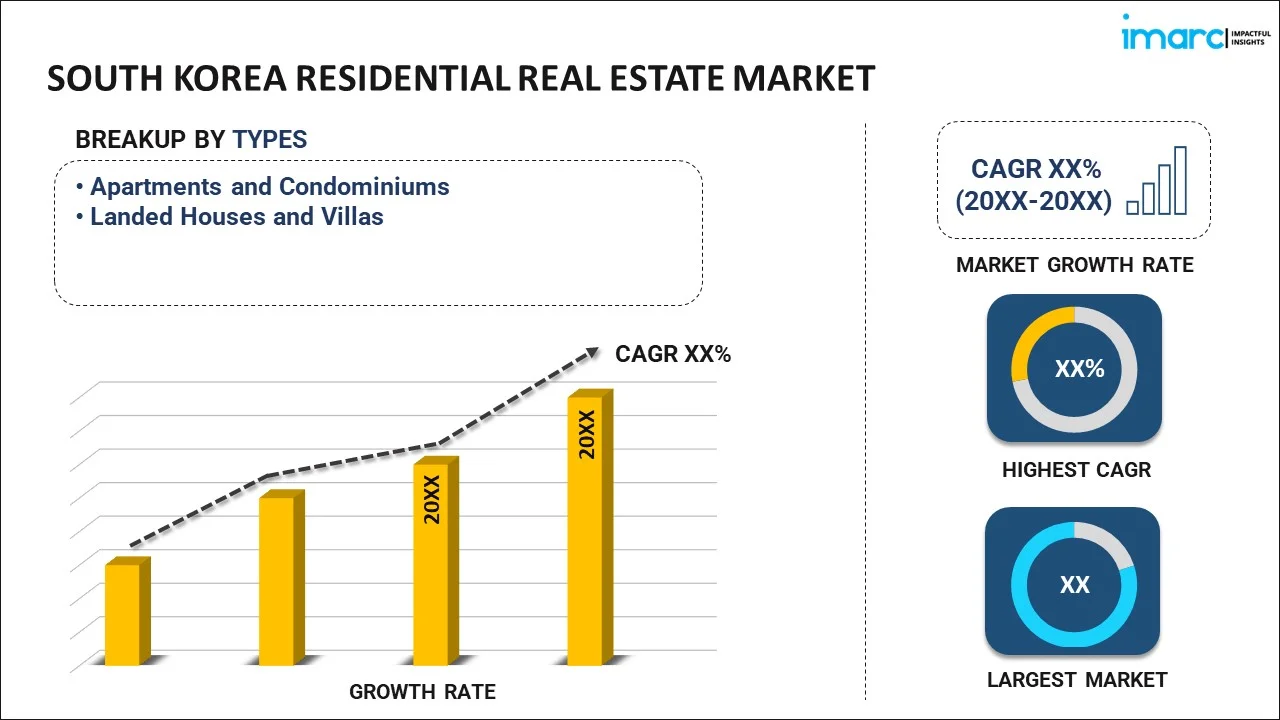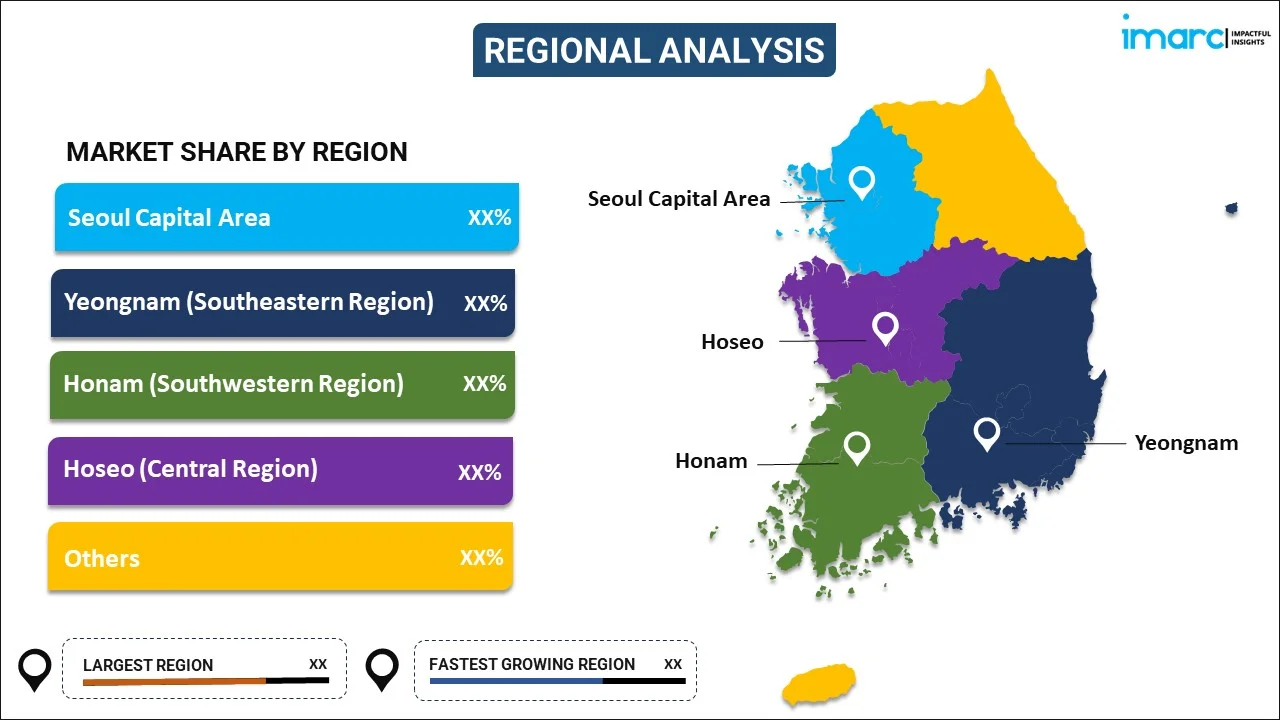
South Korea Residential Real Estate Market Report by Type (Apartments and Condominiums, Landed Houses and Villas), and Region 2025-2033
Market Overview:
South Korea residential real estate market size is projected to exhibit a growth rate (CAGR) of 12.83% during 2025-2033. The growing demand for eco-friendly and sustainable housing options, increasing popularity of smart home technologies and energy-efficient features, and rising focus on purchasing properties for recreational use represent some of the key factors driving the market.
|
Report Attribute
|
Key Statistics
|
|---|---|
|
Base Year
|
2024 |
|
Forecast Years
|
2025-2033
|
|
Historical Years
|
2019-2024
|
| Market Growth Rate (2025-2033) | 12.83% |
Residential real estate comprises a wide range of properties that are designed for residential purposes, such as apartments, houses, townhouses, mobile homes, single-family homes, and condominiums. It can serve as a hedge against inflation and help property owners maintain their purchasing power. It provides a sense of control and ownership that other investments may not offer as it allows property owners to make decisions about their properties, such as renovations, rental terms, and property management. It allows individuals to diversify their investment portfolios and provide a hedge against market volatility. It enables residential property owners to take advantage of various tax deductions and incentives, such as deductions for mortgage interest, property taxes, and depreciation. It benefits property owners from regular rental payments that can help cover mortgage expenses and property maintenance and offer a reliable cash flow. It also assists property owners in earning money without actively participating in daily operations, which provides financial freedom and flexibility. It can be used as collateral for loans and financing that is beneficial for funding other investments or personal financial needs. As it is beneficial in generating a consistent stream of rental income, the demand for residential real estate is rising in South Korea.
South Korea Residential Real Estate Market Trends:
At present, the increasing traction of residential real estate, as it provides future generations with a valuable asset and potential income source, represents one of the major factors influencing the market positively in South Korea. Moreover, rising preferences for smaller households among individuals is strengthening the growth of the market in the country. Apart from this, the growing demand for residential properties due to urbanization and the migration of individuals to major cities is offering a positive market outlook in the country. Additionally, the rising popularity of smart home technologies and energy-efficient features in residential real estate is offering lucrative growth opportunities to industry investors in South Korea. Besides this, the increasing adoption of rental properties among international buyers, especially expatriates and foreign students, is impelling the market growth. In line with this, there is a rise in the demand for eco-friendly and sustainable housing options among individuals that align with sustainability goals. This, coupled with the increasing popularity of feng shui and housing design among individuals, is contributing to the growth of the market in the country. In addition, governing agencies in South Korea are supporting homeownership and property investment by offering numerous tax incentives. Furthermore, the rising focus on purchasing properties for recreational use, typically in tourist destinations, is bolstering the market growth.
South Korea Residential Real Estate Market Segmentation:
IMARC Group provides an analysis of the key trends in each segment of the market, along with forecasts at the country level for 2025-2033. Our report has categorized the market based on type.
Type Insights:

- Apartments and Condominiums
- Landed Houses and Villas
The report has provided a detailed breakup and analysis of the market based on the type. This includes apartments and condominiums and landed houses and villas.
Regional Insights:

- Seoul Capital Area
- Yeongnam (Southeastern Region)
- Honam (Southwestern Region)
- Hoseo (Central Region)
- Others
The report has also provided a comprehensive analysis of all the major regional markets, which include Seoul Capital Area, Yeongnam (Southeastern Region), Honam (Southwestern Region), Hoseo (Central Region), and others.
Competitive Landscape:
The market research report has also provided a comprehensive analysis of the competitive landscape in the market. Competitive analysis such as market structure, key player positioning, top winning strategies, competitive dashboard, and company evaluation quadrant has been covered in the report. Also, detailed profiles of all major companies have been provided.
South Korea Residential Real Estate Market Report Coverage:
| Report Features | Details |
|---|---|
| Base Year of the Analysis | 2024 |
| Historical Period | 2019-2024 |
| Forecast Period | 2025-2033 |
| Units | Million USD |
| Scope of the Report | Exploration of Historical and Forecast Trends, Industry Catalysts and Challenges, Segment-Wise Historical and Predictive Market Assessment:
|
| Types Covered | Apartments and Condominiums, Landed Houses and Villas |
| Regions Covered | Seoul Capital Area, Yeongnam (Southeastern Region), Honam (Southwestern Region), Hoseo (Central Region), Others |
| Customization Scope | 10% Free Customization |
| Post-Sale Analyst Support | 10-12 Weeks |
| Delivery Format | PDF and Excel through Email (We can also provide the editable version of the report in PPT/Word format on special request) |
Key Questions Answered in This Report:
- How has the South Korea residential real estate market performed so far and how will it perform in the coming years?
- What has been the impact of COVID-19 on the South Korea residential real estate market?
- What is the breakup of the South Korea residential real estate market on the basis of type?
- What are the various stages in the value chain of the South Korea residential real estate market?
- What are the key driving factors and challenges in the South Korea residential real estate?
- What is the structure of the South Korea residential real estate market and who are the key players?
- What is the degree of competition in the South Korea residential real estate market?
Key Benefits for Stakeholders:
- IMARC’s industry report offers a comprehensive quantitative analysis of various market segments, historical and current market trends, market forecasts, and dynamics of the South Korea residential real estate market from 2019-2033.
- The research report provides the latest information on the market drivers, challenges, and opportunities in the South Korea residential real estate market.
- Porter's five forces analysis assist stakeholders in assessing the impact of new entrants, competitive rivalry, supplier power, buyer power, and the threat of substitution. It helps stakeholders to analyze the level of competition within the South Korea residential real estate industry and its attractiveness.
- Competitive landscape allows stakeholders to understand their competitive environment and provides an insight into the current positions of key players in the market.
Need more help?
- Speak to our experienced analysts for insights on the current market scenarios.
- Include additional segments and countries to customize the report as per your requirement.
- Gain an unparalleled competitive advantage in your domain by understanding how to utilize the report and positively impacting your operations and revenue.
- For further assistance, please connect with our analysts.
 Inquire Before Buying
Inquire Before Buying
 Speak to an Analyst
Speak to an Analyst
 Request Brochure
Request Brochure
 Request Customization
Request Customization




.webp)




.webp)












